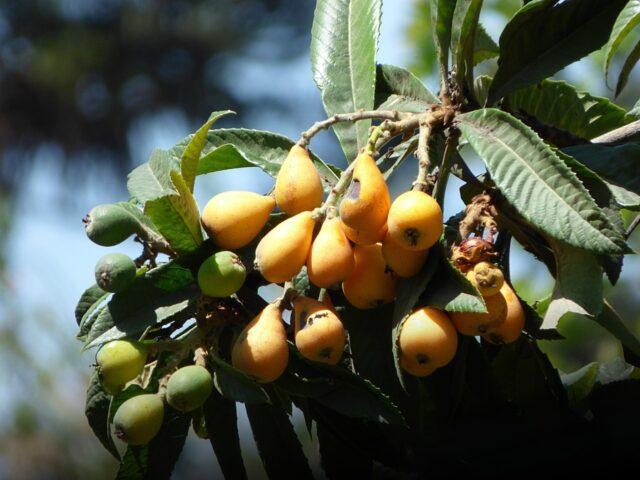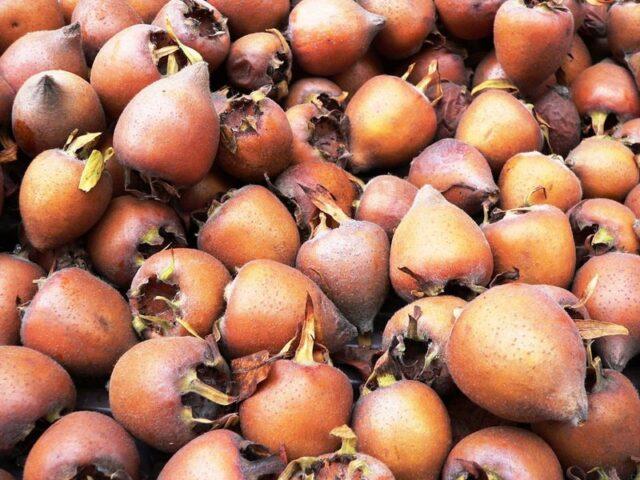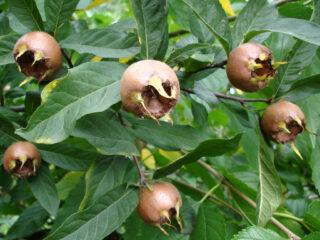Content
Medlar is an evergreen or deciduous crop, which until recently was considered purely decorative. But now it is classified as an edible fruit species. Medlar is a member of the Apple family. There are other names for this culture that can be found in different sources: shesek, lokva, eriobothria.

Medlar is a long-lived tree
Description of medlar with photo
Loquat is a tree whose height under favorable conditions can reach 3-8 m. The crown is dense, spreading, the diameter of its growth is 3-4 m. In one place, medlar can grow and regularly bear fruit for up to 100 years. The culture is considered relatively winter-hardy.
The tree has a shallow, branched root system. Lokva is undemanding to soil composition and can grow on heavy clay soils. Easily withstands partial shade and direct sunlight. Medlar tolerates pruning well, which allows you to regularly rejuvenate the tree. At the same time, new shoots grow quickly and after lignification begin to bear fruit abundantly.
Growing young loquat branches have a reddish tint and a felt edge on the surface. As they mature, their bark turns dark gray. The leaves of this tree are large, oval-oblong. Their length is 30 cm and width 8 cm. Throughout the warm season, the plates have a dark green color, but with the arrival of autumn their shade becomes orange with a reddish tint. Therefore, before frost, the medlar tree looks very elegant. The surface of lokva leaves is hard, leathery, slightly wrinkled between the veins.
The fruits of this exotic tree are round or pear-shaped, depending on the species. Their size is 6-8 cm. When ripe, the fruits become yellow or orange in color. The taste of locva fruit is sweet with a slight sourness. Inside each fruit there are from one to five seeds. They have a hard brown shell. Around the seeds there is edible juicy pulp.

Loqua tastes like a combination of apple, strawberry and pear.
Types and varieties of medlar
There are three types of this culture found in nature. But only two have become widespread in gardening: German and Japanese. Both can easily tolerate a lack of light, as well as a lack of nutrients in the soil. But they also have significant differences.
German
The species is considered largely decorative. German lokva is a compact deciduous tree up to 3 m high. This crop does not require care and is characterized by increased frost resistance compared to other species. German medlar (Mespilus germanica) can withstand temperatures down to -17 degrees, but its shoots freeze.At a frost of -23 degrees the tree completely dies. Therefore, German lokva can be grown in regions with a temperate climate, where winters are warm and summers are cool.
The fruits are round and become honey-yellow when ripe. They taste sweetish, but tart. Therefore, it is recommended to remove them from the tree after the first frost. And to improve the taste before use, it is recommended to keep it in the freezer for several days.

German lokva looks and tastes like quince.
Japanese
The height of this type of tree varies between 3-5 m, but there are specimens reaching 8 m. According to the description of the plant, the Japanese medlar (Eriobotrya japonica) has skeletal branches and young shoots covered with a gray-red edge. The leaves are elongated, dark green with a glossy surface and short petioles. The reverse side of the plates is gray with pubescence.
Japanese loquat is a heat-loving crop that cannot tolerate temperatures dropping to -5 degrees. But at the same time, if the aerial part dies, it has the ability to grow back from the root in the presence of favorable conditions. Cold winter has a negative impact on the fruiting of this species. Therefore, it can only be grown in the southern regions.
The berries of this species can be pear-shaped or round. When ripe they become a rich yellow-orange color. They grow in clusters of 10-12 pieces in one. The pulp inside the berries is juicy and aromatic. The fresh harvest can be stored for no more than three days.

Japanese loquat fruits resemble apricots in appearance.
This type of crop became the basis for the development of new productive varieties:
- Tanaka. It is characterized by pear-shaped fruits, inside of which the flesh is pink. Their taste is sweet and sour.
- Silas. Produces fairly round fruits weighing up to 80 g.When ripe they become a honey-yellow hue.
- Champagne. A distinctive feature of the variety is its round yellow berries with a pubescent surface.
- Morozko. A dwarf species that is suitable for growing at home and in greenhouses. Characterized by large red-brown fruits without astringency.
- Premier. The variety is distinguished by large oval fruits. Their skin is orange in color and slightly pubescent.
In what conditions and countries does medlar grow?
The distribution area of locva coincides with albizia, persimmon and fig. The birthplace of the culture is considered to be China and Japan, where it grows in mountainous areas. Subsequently, medlar was introduced into Europe in the 19th century.
Loqua grows in the subtropics and adjacent areas. Therefore, now it can be found in any corner of the world where there are favorable conditions for its development and fruiting. At the same time, the tree prefers to grow at higher elevations.
This culture has become widespread in India and Southeast Asia. Medlar also grows on the other side of the equator, namely in New Zealand, South Africa and Australia. It was once brought by Chinese emigrants to Hawaii. This plant can be found in South and North America. In the northern regions of Europe, medlar is grown as an ornamental pot plant. Variegated varieties are especially popular.
Where and how does medlar grow in Russia?
On the territory of Russia, Japanese lokva grows only along the Black Sea coast of the Caucasus, where conditions are optimal for it.It can be found between Gelendzhik and Sochi, as well as in the south of Crimea. Medlar is successfully cultivated in Dagestan.
And the Germanic species is sometimes grown by gardeners in the Azov region on their plots. But this exotic culture did not become widespread.
When and how does medlar bloom?
This tree blooms for the first time in the fifth or sixth year after planting. Medlar buds appear at the ends of the shoots and are collected in lush panicle inflorescences. The buds open gradually. The flowers are simple, consisting of five yellowish-white petals. Their diameter when opened is 2.5 cm. Numerous stamens can be seen in the center of each flower. For fruit set, medlar, like all pome and stone fruit crops, requires cross-pollination.

When opened, the buds emit a pleasant, refined aroma.
The flowering period for German and Japanese crop species occurs at different times. In the first case, the medlar blooms buds in May, like other fruit trees in the garden. This period lasts about 14 days.
The Japanese lokva flowers on the tree in winter, namely in mid-February. Therefore, its fruiting period begins much earlier than that of other trees. The duration of flowering for Japanese medlar is 10-14 days, subject to favorable conditions.
When does medlar ripen?
The fruits of German and Japanese medlars ripen at different times. In the first case, this happens in the fall, namely in mid-October - early November. Moreover, the fruits hang on the branches when they no longer have leaves.
The fruiting season for the Japanese medlar begins in late May - early June, when other trees in the garden have just faded. In the event of a severe winter, the tree blooms but does not bear fruit.Therefore, sometimes the harvest can be harvested once every 5-7 years.
Conclusion
Medlar is a crop whose fruits are characterized by a high content of sucrose, fructose and pectins. They can be eaten fresh or used for processing. The leaves of this tree also have beneficial properties. Decoctions based on them are used to treat intestinal infections. However, despite the benefits of medlar, it must be consumed in doses so as not to inadvertently cause harm to health.













